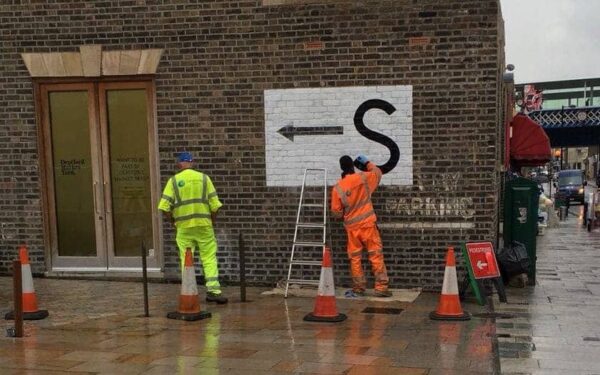14 Sep 2018
It’s All Popping Off in Deptford Market Yard
In Deptford, South East London, the processes of development/gentrification are having an impact on the area’s walls, including ghost signs. The following is cribbed from two Twitter threads, here and here, largely focused on the Deptford Market Yard.
Very pleased to see that the graffiti on the WWII bomb shelter sign by the edge of @DeptfordMktYard has been cleaned. 75+ years of history preserved! 😊 pic.twitter.com/6oW8jL3dIv
— Deptford Society (@deptfordsociety) July 16, 2018
First up is this shelter sign from WW2. On 16 July the Deptford Society tweeted in a celebratory tone given the recent removal of graffiti. However, within a month, the sign had been ‘restored‘, as documented in this article in the Daily Telegraph.

I was alerted to the above repainting in a discussion about the proliferation of painted signs outside stations across South East London. These are part of an ongoing project documented here in the Evening Standard, but much less well received by those on Twitter.
I swear these are multiplying. By 2021 SE London may be nearly 97% twee, experts have warned pic.twitter.com/sxUFk0veIE
— Rob Hyde (@rob_hyde) August 20, 2018
One of the series has even been done in the ‘faux’ ghost signs style.
And then, finally, it’s back to Deptford Market Yard where there was once a prominent Lipton’s Tea ghost sign. Those responsible for the management of the market yard have covered this almost entirely with a large piece of directional signage.
https://twitter.com/TLynskey/status/1019514238484795393
The likely long-term damage to the Lipton’s sign may be limited as the large arrow appears to be a ‘wall wrap’ or similar adhesive product which can be removed. However, it will clearly have some impact, versus leaving the original sign alone. That said, the ghost sign was already a fragment due to a previous partial covering by a billboard.
These sorts of incidents are happening daily around the world, but social media and the proliferation of digital photography facilitates their documentation and discussion. The nature of the changes that they embody serve as focal points for wider social, and particularly urban, issues to be aired and debated. In the case of the above discussions on Twitter the broad consensus appears to be towards the preservation of visible history on the streets in the form of ghost signs, but an objection to the creation of new paintings, or at least those in the style being used for the stations.
The ghost signs clearly play a role in place making, and are valued at a local level. However, the objection to the new signage, which is directional/naming rather than purely commercial, is harder to square with this line of reasoning. It reminds me of the removal of graffiti that covered an Army Club (tobacco) sign on my Stoke Newington walk. It always struck me that this poses interesting questions about what has value, and what is permissable, on ‘our’ streets. And, related, who is making these decisions about the relative merits of historic tobacco advertising versus contemporary graffiti pieces. These walls exist at the intersection of public and private property, and so decisions taken by the latter inevitably affect the former.
I am not asserting an opinion for or against either type of paint on walls, just that we should be conscious of our opinions, how they are formed, and how they might change over time e.g. will a piece of 2018 graffiti ‘revealed’ in 2088 have more or less value than it appears to have today? I think that seeking out the assumptions that underpin the brief comments made on social media posts are worth interrogating, and testing against wider public opinion. I have always maintained that while it is interesting and important to document the history of painted signs in our cities, we shouldn’t let this hold us back from creating the ghost signs of tomorrow.



